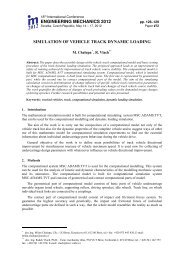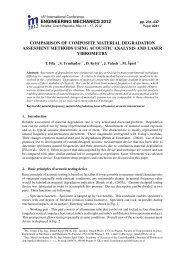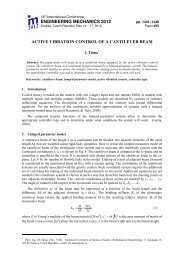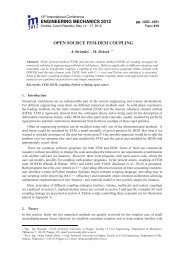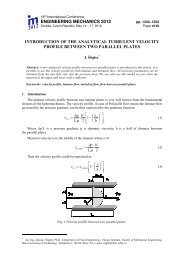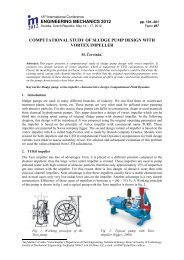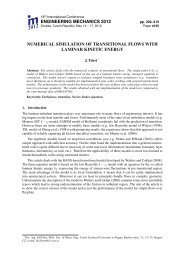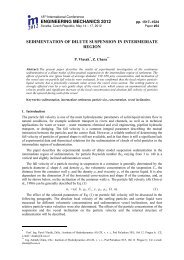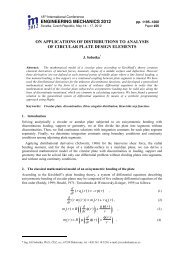prestressed concrete sleeper under extreme loading conditions ...
prestressed concrete sleeper under extreme loading conditions ...
prestressed concrete sleeper under extreme loading conditions ...
- No tags were found...
Create successful ePaper yourself
Turn your PDF publications into a flip-book with our unique Google optimized e-Paper software.
. 18m 2012th International ConferenceENGINEERING MECHANICS 2012 pp. 312–313Svratka, Czech Republic, May 14 – 17, 2012 Paper #222PRESTRESSED CONCRETE SLEEPER UNDER EXTREME LOADINGCONDITIONSJ. Sýkorová * , J. Bártová ** , P. Štemberk ***Abstract: Prestressed <strong>concrete</strong> <strong>sleeper</strong>s are among the most common structural components of therailway tracks. Nowadays, the majority of railway <strong>sleeper</strong>s are made of <strong>prestressed</strong> <strong>concrete</strong>. Duringtheir service life, the <strong>sleeper</strong>s are subjected to <strong>extreme</strong> <strong>loading</strong> <strong>conditions</strong>, which may drastically reducethe span of their service life. This paper focuses on the optimized design of <strong>prestressed</strong> railway <strong>sleeper</strong>subjected to <strong>extreme</strong> <strong>loading</strong> <strong>conditions</strong>, which represented here by the impact of a flat wheel and by thecyclic <strong>loading</strong>.Keywords: Extreme <strong>loading</strong>, <strong>prestressed</strong> <strong>concrete</strong> <strong>sleeper</strong>, optimization, cyclic <strong>loading</strong>, fatigue.1. IntroductionThe classical railway track consists of the rails, fasteners, <strong>sleeper</strong>s, ballast and <strong>under</strong>lying subgrade.The railway <strong>sleeper</strong>s lie on the ballast transversally to the rails, which supports and holds them inplace, and provides drainage and flexibility. The <strong>sleeper</strong>s transfer the loads from rails to the ballast andsubgrade, hold the rails to the correct gauge, restrain longitudinal and lateral rail movements, andprovide strength and stability to whole track structure. It is obvious that the <strong>sleeper</strong>s are subjected to<strong>extreme</strong> <strong>loading</strong> <strong>conditions</strong> and their design should be provided with high attention.2. Loading of railway <strong>sleeper</strong>sThe whole railway track is subjected to static and dynamic load, which is caused by traintransportation. The design static wheel load per rail seat for standard railway tracks is 125 kN. But itshould be noted that the railway tracks often suffer from <strong>extreme</strong> <strong>loading</strong> <strong>conditions</strong>. The <strong>extreme</strong><strong>loading</strong> is attributed to the wheel and rail abnormalities, which are, for example, the flat wheels, wheelcorrugation, out-of-round wheels, dipped rails, etc. These defects can cause <strong>loading</strong> of a very highmagnitude but short duration and the occurrence of such <strong>loading</strong> is of low probability during thedesign life of the <strong>sleeper</strong> (Kaewunruen & Remennikov, 2009). The magnitude of the dynamic impactloads per rail seat varies from 200 kN up to 750 kN (Remennikov & Kaewunruen, 2008). These forcesmay cause cracking and failure of the <strong>sleeper</strong> (Sýkorová, et al., 2011).Railway <strong>sleeper</strong> is a structural element which is subjected to cyclic <strong>loading</strong> during its entire servicelife. The cyclic <strong>loading</strong> causes fatigue of <strong>concrete</strong>, which results in permanent progressive changes inthe structure of the material. These changes can cause crack, or micro-crack, propagation whichconsequently reduces stiffness of the structure, which in the <strong>extreme</strong> case can lead to fatigue failure.3. Numerical analysis of railway <strong>sleeper</strong>The resulting shape of the <strong>sleeper</strong> was obtained by the optimization of the shape of the standard B70<strong>prestressed</strong> <strong>concrete</strong> mono-block <strong>sleeper</strong>. The prestressing force and the position of prestressing wiresare then determined accordingly for the optimized shape of the <strong>sleeper</strong>.*Ing. Jana Sýkorová: Czech Technical University in Prague, Faculty of Civil Engineering, Thákurova 7, 166 29, Prague 6;CZ, e-mail: jana.sykorova.1@fsv.cvut.cz** Ing. Jana Bártová: Czech Technical University in Prague, Faculty of Civil Engineering, Thákurova 7, 166 29, Prague 6;CZ, e-mail: jana.bartova@fsv.cvut.cz*** doc. Ing. Petr Štemberk, Ph.D.: Czech Technical University in Prague, Faculty of Civil Engineering, Thákurova 7, 16629, Prague 6; CZ, e-mail: stemberk@fsv.cvut.cz
Sýkorová J., Bártová J., Štemberk P. 3133.1. Optimized design of the <strong>concrete</strong> <strong>sleeper</strong> for the standard load and the impact of flat wheelThe problem is divided into two cases. The first case is related to the design of the <strong>sleeper</strong> to withstandthe standard load of 125 kN per rail seat. The second case deals with the design of the <strong>sleeper</strong> towithstand the load of 400 kN per rail seat, which represents the impact of the flat wheel. The necessaryprestressing reinforcement is provided with the identical prestressing wires with the proof test of 1860MPa. The <strong>sleeper</strong> with standard load of 125 kN on both rail seats is <strong>prestressed</strong> with 10 wires with thediameter of 6 mm. The <strong>sleeper</strong> designed for impact load of 400 kN on both rail seats is <strong>prestressed</strong>with 12 wires with the diameter of 8 mm. The 28-day compressive strength of <strong>concrete</strong> used in theanalysed <strong>sleeper</strong> must be greater than 50 MPa.3.2. Cyclic <strong>loading</strong>The railway <strong>sleeper</strong> is subjected to cyclic <strong>loading</strong> which causes fatigue of <strong>concrete</strong>. The analysis of the<strong>prestressed</strong> <strong>concrete</strong> <strong>sleeper</strong> <strong>under</strong> fatigue load is done for the <strong>sleeper</strong> with standard load of 125 kN onboth rail seats. The most important characteristic when analysing the fatigue behaviour of <strong>concrete</strong> isthe decrease of stiffness, which is calculated here by using fatigue damage function (Foglar, 2008;Sýkorová et al., 2008). This function depends on the total number of load cycles and the load level.The total number of load cycles which the <strong>prestressed</strong> <strong>concrete</strong> railway <strong>sleeper</strong> can resist during itsservice life, was determined by formulae in Eurocode 2 (CEN, 2005) as 80 millions. With respect tothe maximum and minimum compressive stresses in the cross section <strong>under</strong> the rail seat, the load levelis determined as 0.44. The modulus of elasticity decreases rapidly during the first few hundredthousands of load cycles and then again at the end of its service life. During the first 10 per cent of allload cycles the mean value of the modulus of elasticity decreases from the initial value of 37 GPa to26.2 GPa. Such reduction of stiffness results in greater deformations and even in cracking and thus inreduction of the expected service life.4. ConclusionsThis paper presented an analysis of <strong>prestressed</strong> <strong>concrete</strong> railway <strong>sleeper</strong> subjected to two types of<strong>extreme</strong> <strong>loading</strong> <strong>conditions</strong>. Railway <strong>sleeper</strong> can suffer during its service life from impact load causedby flat wheels. Therefore, the standard shape of the <strong>sleeper</strong> known as B70 was optimized and theprestressing force designed so that it can withstand the impact load of 400 kN instead of the ordinary125 kN per rail seat. Railway <strong>sleeper</strong> is also structure which is subjected to cyclic <strong>loading</strong>. Cyclic<strong>loading</strong> of the railway <strong>sleeper</strong>s commonly exceeds 80 millions of cycles during their service life whichis commonly more than 40 years. Therefore, the optimized railway <strong>sleeper</strong> was analysed for the effectof cyclic <strong>loading</strong> which causes fatigue of structural elements. For the analysis of reduction of stiffnessduring the cyclic <strong>loading</strong> was used cyclic damage function.AcknowledgementThe financial support by the Czech Science Foundation, project P105/10/2098, and the CTU inPrague, project SGS11/107/OHK1/2T/11, which is gratefully acknowledged.ReferencesEurocode 2 - Design of Concrete Structures - Concrete Bridges - Design and detailing Rules (2005) CEN.Foglar, M. (2008) Strain development <strong>under</strong> cyclic <strong>loading</strong>. Ph. D. Thesis, CTU in Prague, Prague.Kaewunruen, S. & Remennikov, A. M. (2009) Progressive failure of <strong>prestressed</strong> <strong>concrete</strong> <strong>sleeper</strong>s <strong>under</strong> multiplehigh-intensity impact loads. Engineering Structures, 31, pp.2460-2473.Remennikov, A. M. & Kaewunruen, S. (2008) A review on <strong>loading</strong> <strong>conditions</strong> for railway track structures due towheel and rail vertical interactions. Progress in Structural Engineering and Materials, 15, pp.207-234.Sýkorová, J., Bártová, J. & Štemberk, P. (2011) Analysis of Prestressed Concrete Sleeper <strong>under</strong> ExtremeLoading Conditions, in: Mechanika 2011 - Proceedings of the 16th International Conference, Kaunotechnologijos universitetas, Kaunas, pp.282-286.Sýkorová, J., Foglar, M. & Štemberk, P. (2008) Fatigue of reinforced <strong>concrete</strong> bridges with influence ofdeterioration of <strong>concrete</strong>, in: Microstructure Related Durability of Cementitious Composites – Proceedings ofthe First International Conference, Bagneux: Rilem Publications s.a.r.l., pp.825-832.



